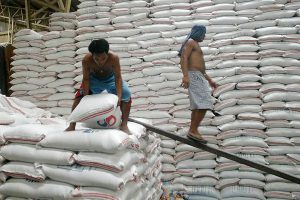THE national rice inventory rose 5.4% year on year to 2.15 million metric tons (MMT), the Philippine Statistics Authority (PSA) reported, citing preliminary data as of Oct. 1.
The national inventory consisted of 52.6% held by commercial traders, 39.4% by households, and 8% by the National Food Authority (NFA), the PSA said in a report.
Rice held by the NFA increased 290.2% to 172,840 MT, while commercial rice stocks rose 4.7% to 1.08 MMT.
On the other hand, rice held by households amounted to 849,330 MT for the period, down 7.5% from a year earlier. Month on month, their holdings rose 29.8%.
The PSA also said the corn inventory declined 25.3% year on year to 728,230 MT during the period.
Corn held by commercial establishments was 585,390 MT, down 31.1%, while household corn was around 142,840 MT, up 13.7%.
At the World Rice Conference Summit on Wednesday, Agriculture Undersecretary Deogracias Victor B. Savellano, who delivered a speech on behalf of Secretary Francisco P. Tiu Laurel, Jr., described the Philippine rice supply as secure.
“Working closely with President Ferdinand R. Marcos, Jr., we are accelerating harvest and procurement through the NFA, which plays a crucial role in supporting communities affected by severe tropical storm Kristine,” Mr. Savellano said.
“Region 5 and Calabarzon have felt this impact and the NFA’s efforts are critical in these areas,” he added.
He said that the challenges brought about by natural events like El Niño and La Niña are testing the resilience of farmers.
“El Niño has intensified droughts and reduced water availability, while La Niña has led to heavy rains and flooding in some areas. Together, these events underscore the need for more adaptive measures in our rice production,” he said.
To address this, he said that DA is working with the International Rice Research Institute for potential scaling up of new technologies focused on nutritious rice, high-productivity rice, climate-resilient rice, and low-carbon rice.
“These innovations have the power to increase farmers’ yields, improve their incomes, and support the nation’s food and nutrition security,” he added.
At present, the Philippines can meet 79% of its rice demand with domestically grown rice, which the government hopes to increase to 95% by 2028. — Justine Irish D. Tabile
